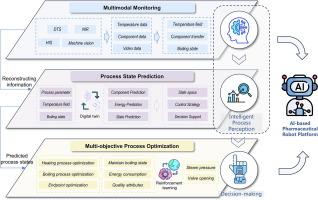如何打造中药产业新生产力:工业感知智能与人工智能制药机器人
IF 11.6
1区 工程技术
Q1 ENGINEERING, MULTIDISCIPLINARY
引用次数: 0
摘要
提取装置的操作是中药产品生产的第一步,是决定中药产品质量的关键环节。然而,由于缺乏有效的多式联运监测和调整战略,实现高质量和高效率仍然是一项挑战。在这项工作中,我们提出了一个基于人工智能(AI)的机器人平台,用于多目标优化提取过程。首先,建立了一种多模态过程监测感知智能方法,跟踪提取过程中活性成分的转移和生产变化。其次,建立了与实时监测数据交互的现场信息重构数字孪生模型;此外,该模型利用重构信息进行实时推理,预测未来生产过程状态。最后,根据预测的过程状态,自主决策机器人进行多目标优化,确保高效的过程调整以实现全局优化。实验和工业结果表明,该平台可以有效地推断组分传递动态,监测温度变化,识别沸腾状态,在保证产品质量的同时降低能耗。该制药机器人可以促进人工智能与制药工程的融合,从而加速中国制药行业的迭代发展和完善。本文章由计算机程序翻译,如有差异,请以英文原文为准。


How to Build New Productive Forces for Traditional Chinese Medicine Industry: Industrial Perception Intelligence and AI-Based Pharmaceutical Robot
Extraction unit operation is the first step in traditional Chinese medicine (TCM) product manufacturing, and it is crucial in determining the quality of the produced medicine. However, due to a lack of effective multimodal monitoring and adjustment strategies, achieving high quality and efficiency remains a challenge. In this work, we proposed an artificial intelligence (AI)-based robot platform for the multi-objective optimization of the extraction process. First, a perception intelligence method for multimodal process monitoring was established to track active ingredient transfer and production changes during the extraction process. Second, a digital twin model was developed to reconstruct the field information, which interacted with real-time monitoring data. Furthermore, the model performed real-time inference to predict future production process states by using the reconstructing information. Finally, according to the predicted process states, the autonomous decision-making robot implemented multi-objective optimization, ensuring efficient process adjustments for global optimization. Experimental and industrial results demonstrated that the platform could effectively infer component transfer dynamics, monitor temperature variations, and identify boiling states, ensuring product quality while reducing energy consumption. This pharmaceutical robot could promote the integration of AI and pharmaceutical engineering, thereby accelerating the iterative development and improvement of China’s pharmaceutical industry.
求助全文
通过发布文献求助,成功后即可免费获取论文全文。
去求助
来源期刊

Engineering
Environmental Science-Environmental Engineering
自引率
1.60%
发文量
335
审稿时长
35 days
期刊介绍:
Engineering, an international open-access journal initiated by the Chinese Academy of Engineering (CAE) in 2015, serves as a distinguished platform for disseminating cutting-edge advancements in engineering R&D, sharing major research outputs, and highlighting key achievements worldwide. The journal's objectives encompass reporting progress in engineering science, fostering discussions on hot topics, addressing areas of interest, challenges, and prospects in engineering development, while considering human and environmental well-being and ethics in engineering. It aims to inspire breakthroughs and innovations with profound economic and social significance, propelling them to advanced international standards and transforming them into a new productive force. Ultimately, this endeavor seeks to bring about positive changes globally, benefit humanity, and shape a new future.
 求助内容:
求助内容: 应助结果提醒方式:
应助结果提醒方式:


